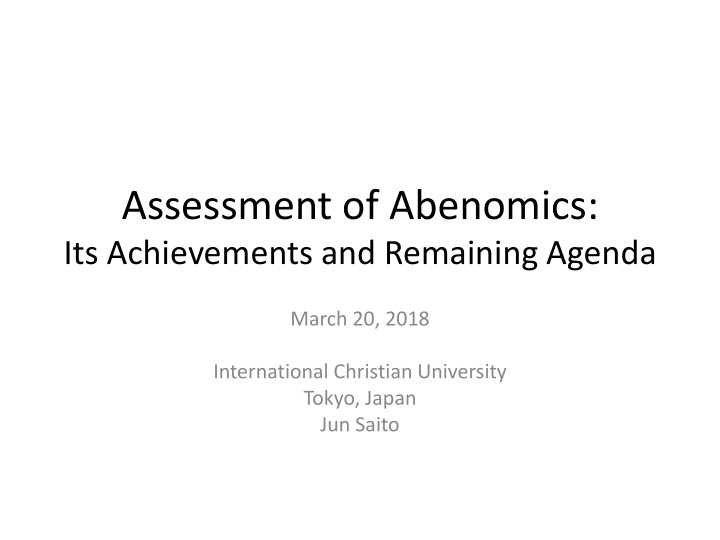



Assessment of Abenomics: Its Achievements and Remaining Agenda March 20, 2018 International Christian University Tokyo, Japan Jun Saito
-1 0 1 2 3 4 5 6 7 8 9 (Percent) Jul-85 (Data Source) Bank of Japan Jul-86 Jul-87 Jul-88 Short-Term Interest Rate and Jul-89 Jul-90 Jul-91 Jul-92 Jul-93 Jul-94 Jul-95 Monetary Base Jul-96 Jul-97 Call rate (overnight uncollateralized) Monetary base (right scale) Jul-98 Jul-99 Jul-00 Jul-01 Jul-02 Jul-03 Jul-04 Jul-05 Jul-06 Jul-07 Jul-08 Jul-09 Jul-10 Jul-11 Jul-12 Jul-13 Jul-14 Jul-15 (Trillion yen) Jul-16 Jul-17 -50 50 150 250 350 450 550
Budget Appropriation for Public Works (Trillion yen) 16 Supplementary Budget 14 Initial Budget 12 Abenomics 10 8 6 4 2 0 1989 1990 1991 1992 1993 1994 1995 1996 1997 1998 1999 2000 2001 2002 2003 2004 2005 2006 2007 2008 2009 2010 2011 2012 2013 2014 2015 2016 2017 p2018 (Fiscal year) (Data source) Ministry of Finance 3
Real GDP Growth Rate (Rate of change of seasonally adjusted series, in percent) 2 Abenomics 1.5 1 0.5 0 -0.5 Net Exports -1 PublicDemand -1.5 PrivateDemand -2 -2.5 GDP(Expenditure Approach) -3 Ⅰ Ⅱ Ⅲ Ⅳ Ⅰ Ⅱ Ⅲ Ⅳ Ⅰ Ⅱ Ⅲ Ⅳ Ⅰ Ⅱ Ⅲ Ⅳ Ⅰ Ⅱ Ⅲ Ⅳ Ⅰ Ⅱ Ⅲ Ⅳ 2012 2013 2014 2015 2016 2017 (Data Source) Economic and Social Research Institute of Cabinet Office
Output Gap (Ratio to GDP, in percent) 1.5 Abenomics 1.0 0.5 0.0 -0.5 -1.0 -1.5 -2.0 Ⅰ Ⅱ Ⅲ Ⅳ Ⅰ Ⅱ Ⅲ Ⅳ Ⅰ Ⅱ Ⅲ Ⅳ Ⅰ Ⅱ Ⅲ Ⅳ Ⅰ Ⅱ Ⅲ Ⅳ Ⅰ Ⅱ Ⅲ Ⅳ 2012 2013 2014 2015 2016 2017 (Data Source) Cabinet Office
Labor Market Indicators (Percent) 5.0 1.8 Abenomics 4.5 1.6 4.0 1.4 3.5 1.2 3.0 1 Unemployment rate 2.5 0.8 Job offers to applicants ratio (right scale) 2.0 0.6 Jan Mar May Jul Sep Nov Jan Mar May Jul Sep Nov Jan Mar May Jul Sep Nov Jan Mar May Jul Sep Nov Jan Mar May Jul Sep Nov Jan Mar May Jul Sep Nov Jan 2012 2013 2014 2015 2016 2017 2018 (Data source) Statistics Bureau of Ministry of Internal Affairs and Communications, and Ministry of Health, Labour and Welfare
Consumer Price Index (Year-on-year rate, in percent) 2.5 Abenomics 2 1.5 1 0.5 0 -0.5 CPI (Headline) CPI (excluding fresh foods) -1 CPI (excluding fresh foods and energy) -1.5 Jan Mar May Jul Sep Nov Jan Mar May Jul Sep Nov Jan Mar May Jul Sep Nov Jan Mar May Jul Sep Nov Jan Mar May Jul Sep Nov Jan Mar May Jul Sep Nov Jan 2012 2013 2014 2015 2016 2017 2018 (Data source) Ministry of Internal Affairs and Communications (Note) All series are adjusted for the consumption tax rate-hike.
OECD: General Government Fiscal Financial Balance Estimates for 2017 (Percent of GDP) 6.0 4.0 2.0 0.0 -2.0 -4.0 -6.0 (Data Source) OECD, Economic Outlook (November 2017)
OECD : General Government Gross Financial Liabilities Estimates for 2017 (Percent of GDP) 250 200 150 100 50 0 (Data Source) OECD, Economic Outlook (November 2017)
Regular and Non-Regular Employees (Ten thousands) 6000 Abenomics 5000 4000 3000 2000 Non-regular employee 1000 Regular employee 0 1984 1985 1986 1987 1988 1989 1990 1991 1992 1993 1994 1995 1996 1997 1998 1999 2000 2001 2002 2003 2004 2005 2006 2007 2008 2009 2010 2011 2012 2013 2014 2015 2016 2017 (Data Source) Ministry of Health, Labour and Welfare (Note) Figures between 1984 and 2001 are for February, while the figures for 2002 and thereafter are for averages of the January-March quarter.
Population Projection Total population ( Thousands) 160,000 2008: Projection 128,083 Auxiliary projection 140,000 (Peak) 120,000 2015: 127,095 100,000 (100%) 80,000 2065: 88,077 60,000 (69.3%) 2115: 40,000 50,555 (39.8%) 20,000 0 1965 1969 1973 1977 1981 1985 1989 1993 1997 2001 2005 2009 2013 (2017) (2021) (2025) (2029) (2033) (2037) (2041) (2045) (2049) (2053) (2057) (2061) (2065) <2069> <2073> <2077> <2081> <2085> <2089> <2093> <2097> <2101> <2105> <2109> <2113> ( Data Source) National Institute of Population and Social Security Research, Population Projection for Japan , April 2017. 11
Potential Growth Rate (Percent) 6.0 Labour Input 5.0 Capital Input Total Factor Productivity (TFP) 4.0 Potential GDP Growth Rate 3.0 2.0 1.0 0.0 -1.0 Ⅰ Ⅳ Ⅲ Ⅱ Ⅰ Ⅳ Ⅲ Ⅱ Ⅰ Ⅳ Ⅲ Ⅱ Ⅰ Ⅳ Ⅲ Ⅱ Ⅰ Ⅳ Ⅲ Ⅱ Ⅰ Ⅳ Ⅲ Ⅱ Ⅰ Ⅳ Ⅲ Ⅱ Ⅰ Ⅳ Ⅲ Ⅱ Ⅰ Ⅳ Ⅲ Ⅱ Ⅰ Ⅳ Ⅲ Ⅱ Ⅰ Ⅳ Ⅲ Ⅱ Ⅰ Ⅳ Ⅲ Ⅱ Ⅰ Ⅳ Ⅲ 198081 82 83 84 85 86 87 88 89 90 91 92 93 94 95 96 97 98 99200001 02 03 04 05 06 07 08 09 10 11 12 13 14 15 16 17 (Data Source) Cabinet Office
Inward FDI Stocks (At end of 2016) (Percent of GDP) 400 350 300 250 200 150 100 50 0
Labor Force Participation Rate ( Percent) ( 2016 ) 100 90 80 70 60 50 40 30 20 10 0 Male Female (Data source) Statistics Bureau of Ministry of Internal Affairs and Communications 14
Total Fertility Rate 5 3,000,000 Number of births (right scale) 4.5 2,500,000 Total fertility rate 4 2,000,000 3.5 3 1,500,000 2.5 1,000,000 2 500,000 1.5 1 0 1947 1950 1955 1960 1965 1970 1975 1980 1985 1990 1995 2000 2005 2010 2015 2017 (Data Source) Ministry of Health, Labour, and Welfare. 15
Foreign Workers (Ratio to total labor force) • Japan 1.9 percent (2017 ) • Germany 9.4 percent ( 2009 ) • France 5.8 percent ( 2009 ) • UK 9.6 percent ( 2015 ) • USA 16.2 percent ( 2009 ) • Korea 2.1 percent ( 2015 ) • Singapore 38.2 percent ( 2015 ) (Data Source) Japan Institute for Labour Policy and Training, and Ministry of Health, Labour, and Welfare. 16
Thank you for your attention! International Christian University Tokyo, Japan Jun Saito
Recommend
More recommend